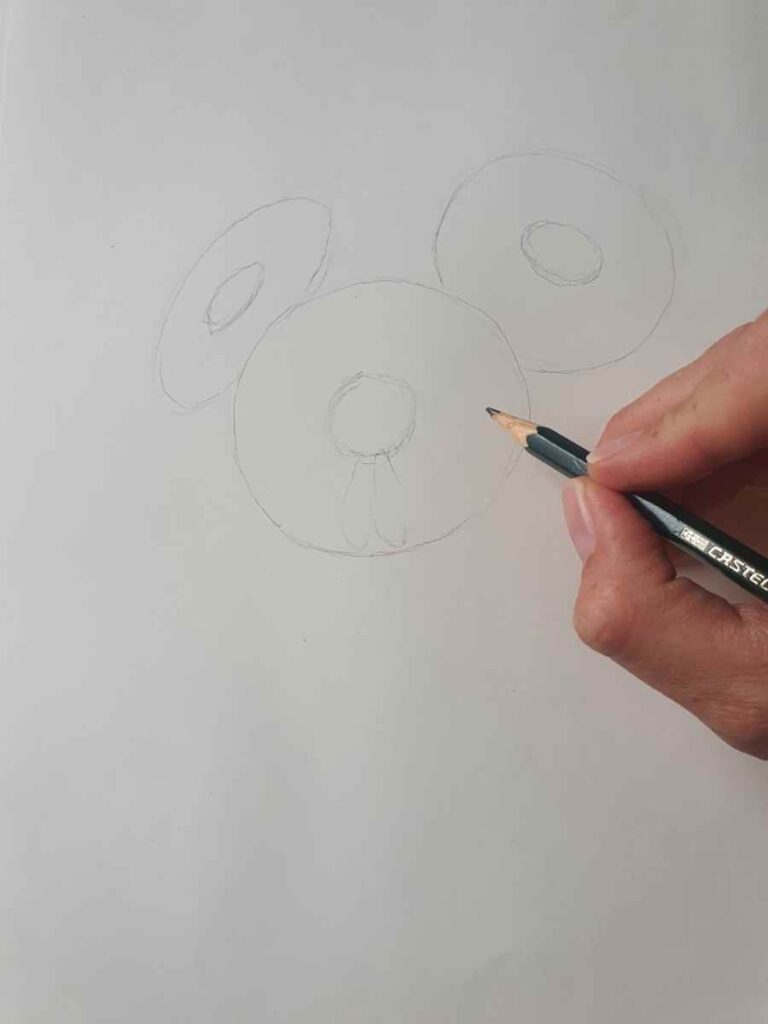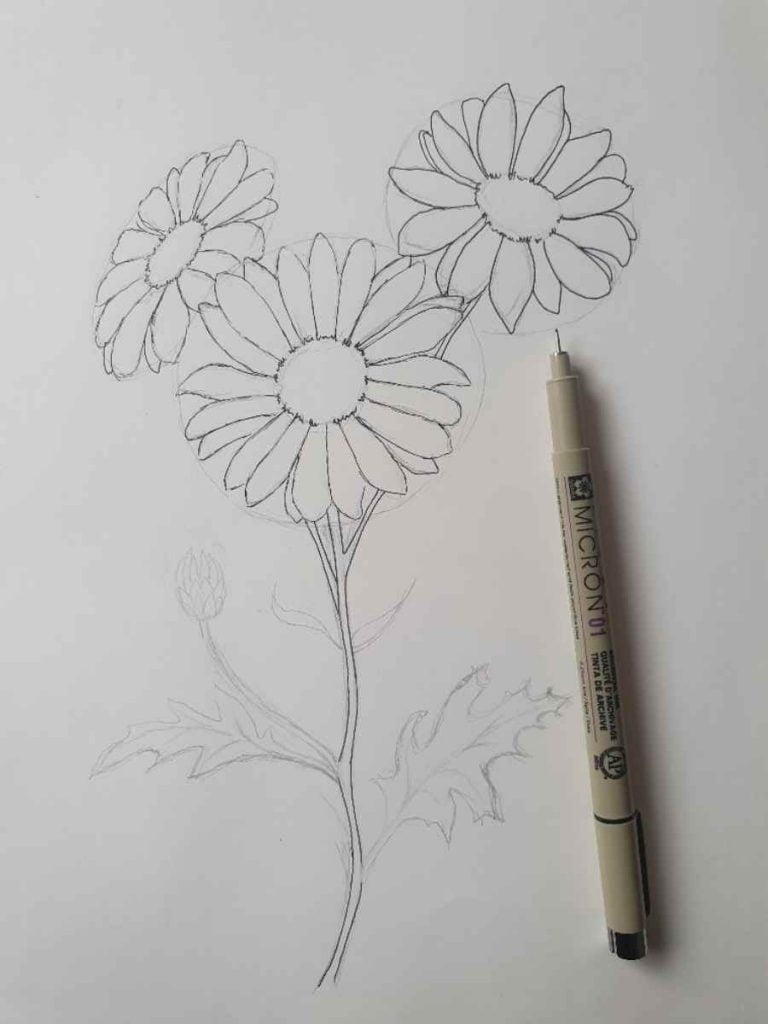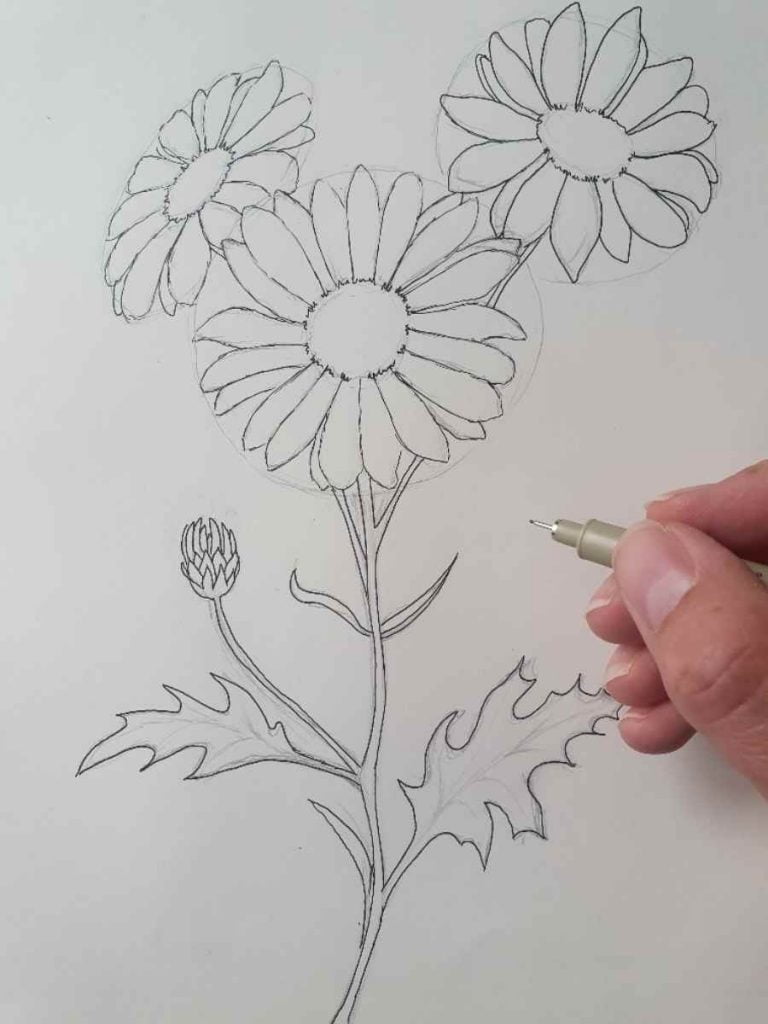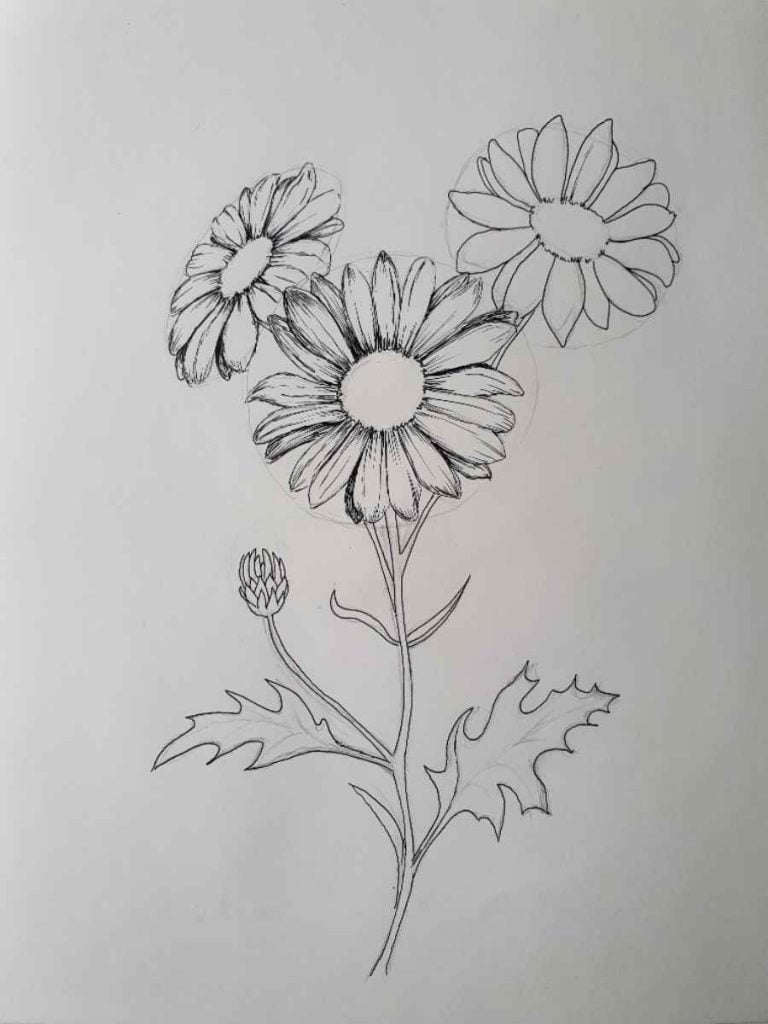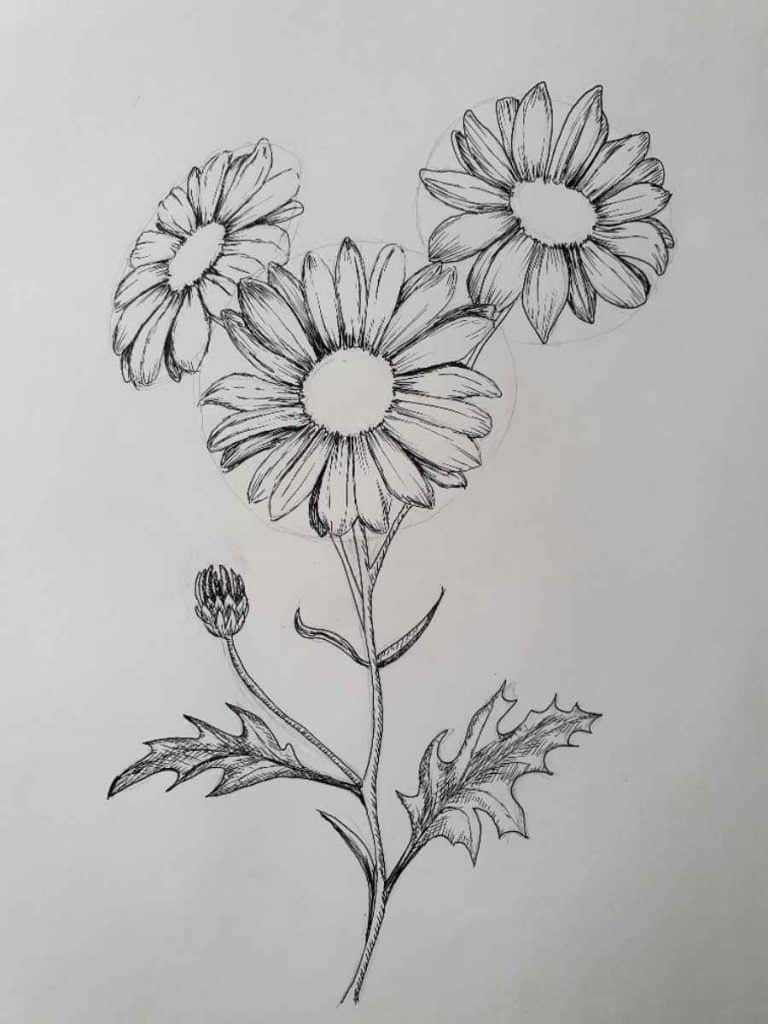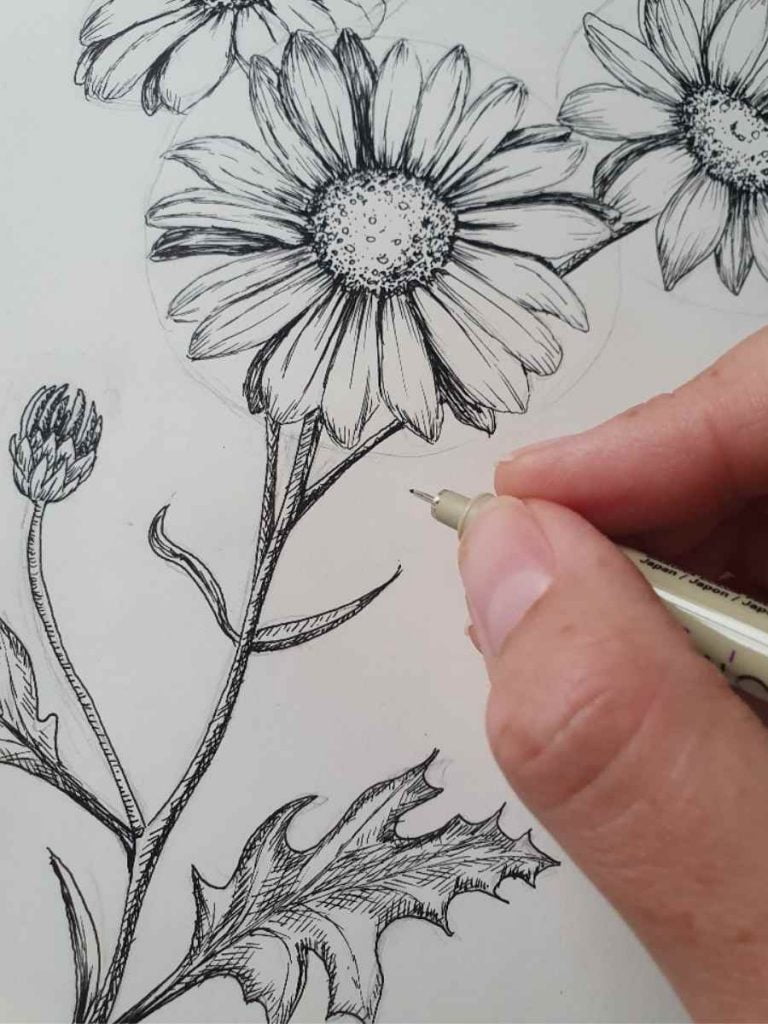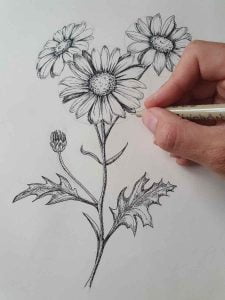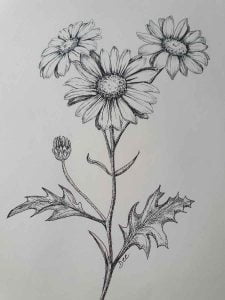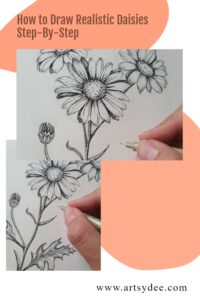Last Updated on February 13, 2023 by Dee
I have always liked daisies because of their pretty colors, symmetrical shape, and the way they become like a spotted pattern on the landscape. As per request, here is a breakdown of how to do a daisy flower drawing step-by-step!
Daisies are a symbol of purity and innocence and are an important wildflower for bees and butterflies. On top of that, daisies also have a long list of medicinal properties!
So, how can you do your own daisy flower drawing?
Daisy Flower Drawing: Step by step Tutorial
Step 1- Collecting your reference material
Whenever you paint a plant or flower, it is a good idea to get a clear and good quality reference image to work from.
Work from your imagination
You can work from your imagination, but the truth is that most people’s brains leave out important information about the original flower. As a result, the daisy sketch may be more stylized or simplified than the original.
If you want to paint a flower or plant in a more abstracted or expressionistic manner, then it is absolutely fine to work with a more stylized, simplified drawing. In this case, drawing from your imagination would work well.
In this drawing demonstration, I wanted to capture the fine details of the daisies, as well as accurately render the lights and dark areas.
Work from your own photos
Drawing from your own photos is a great way to come up with unique ideas and compositions. You also have first-hand experience of what the daisies look like in a real-life situation. This gives you a better idea of how the subject matter “sits in space’ so to speak.
Work from a free stock photo
Because I wanted a level of naturalism in my artwork, I chose to work from a photograph of daisies that I found on unsplash.com.
If you cannot get your own photographs of your chosen subject matter, then you can always use free images from unsplash.com or pexel.com. There are a huge variety of free stock photo sites on the web, but these two are the ones I have used the most for good reference photos.
Step 2: Decide on the size of your drawing
I find that working on an A4 or A3 sheet of watercolor paper is a good size to start off with for botanical art. The cherry blossoms I painted are on an A4 sheet of paper.
I would recommend sticking to at least A4 in size, because if you work any smaller you may struggle to get a good amount of detail in your drawing or painting.
Interestingly enough, working on a larger surface is a lot easier than on a smaller surface.
With a larger sheet of paper, you can accentuate details and there is space to enlarge tiny areas. Your brush strokes can be wider and there is more room for error in a sense.
Step 3: Composition and rough drawing of the general shapes of the Daisy
Once you have decided on the size of the paper you will be working on, you can think about your composition and then draw it out in pencil.
Think carefully about how you will position the Daisy flower on your page to capture a sense of realistic depth. Try to position your subject matter so that it forces the viewer’s eye to move around the surface of the paper. I have chosen to draw three daisy flowers attached to a single stem because 3 is an odd number and it creates a better balance in my composition.
I recommend using a 2B lead pencil to first softly sketch out the general shapes of the daisy’s petals, leaves and stem. Make sure you are applying only a very light pressure onto the pencil to achieve very light pencil marks on the page.
The heads of the three daisies I have chosen fit into 3 disk-like shapes. The disks on the left and right are slightly oblong. Once I have sketched out the disk shapes and am happy with their positions I begin to draw the outline of the petals, daisy centre, stem and leaves of the plant.
Step 4: Defining Form and Using Pen to Outline the Shapes
Once you have sketched the light general shapes of the daisy, then you can start going over the petals, stem, and leaf again and making changes and alterations to your shapes in order to get your subject matter looking more accurate.
At this stage of the process, you can also use your artistic license to add elements like additional leaves, stems or buds to your artwork to complete the composition.
Using a good quality fine-liner black pen (like the Sakura Micron or the Faber Castell Pitt Pen) go over your pencil outline and define your shapes.
Step 5: Begin shading
Remember to check where your light source is! This is so important in order to accurately draw forms and get a sense of three-dimensionality. Your shadows will fall opposite your light source.
There are several shading techniques you can use to shade in your daisy flower, stem and leaves – cross-hatching, hatching, scribbling, stippling and grading.
[Related Post: How to Improve your Drawing…Follow These Top Tips!]
I personally find that using combination of shading techniques to build up density of form and deepen my shadows works really well.
Step 6: Continue shading and add the markings to the petals
Continue to deepen your shading and shadows.
Step 7: Final Details
Carefully observe your drawing and deepen any shadows that need to be darker. You can use your kneadable eraser to pick up pencil marks in order to clean up your page at the end.
If you would like to take your pencil drawing a step further, you can add color to the daisy by applying soft washes of watercolor paint over the pen (provided you have used a permanent, waterproof pen like the Sakura Micron or the Faber Castell Pitt Pen).
Step 8: Paint washes of your lightest color
If you have decided to watercolor your daisy drawing I suggest you begin by using a technique called wet-on-dry. Essentially that means you are putting paint on your paintbrush and then painting directly onto the dry surface of the page. This is a good way to start because you have more control over the areas you are painting color.
Once you have lightly defined your shapes using your initial color you can then work into them using a technique called wet on wet.
Wet on wet is where you paint you paint your watercolor paint onto a watery surface. The color then blooms and bleeds and creates interesting washes of color. This is less controlled than wet-on-dry, but I love watching how the watercolor pigment creates gorgeous textures and patterns as it dries.
[Related Post: How to Paint Gorgeous Cherry Blossoms]
Remember the following when drawing…
Make sure to stand back regularly to observe how your drawing is developing. It is also important that you give yourself mental and visual breaks so that you can continue to draw accurately.
Remember to keep your pencil sharp. This is important because often we get so engrossed in our drawing that we forget that a sharp pencil helps with fine lines and details.
It is a good idea to always have a scrap piece of paper nearby, in order to test out your shapes and shading techniques!
List of materials and supplies needed to do your own Daisy Flower Drawing
The Best Painting and Drawing Supplies for Artists2B, 4B, 6B and 8B Pencil
Kneadable Eraser
Scrap piece of paper for testing colors
300gsm Watercolor Paper: If you want to add a wash to your drawing you should definitely do your drawing on a good-quality, heavy paper that doesn’t buckle.
Soft Bristle Round or Filbert Brush
Watercolor pans or tubes. I am currently using the Windsor and Newton Watercolor Pan. The colors are rich and the tray itself is portable and easy to use.
Conclusion
Drawing a daisy is a fun and easy sketching project for beginners as well as more advanced artists. I hope you have found my advice on techniques and materials to be useful as you begin your own daisy flower drawing!
Other articles you may enjoy…

